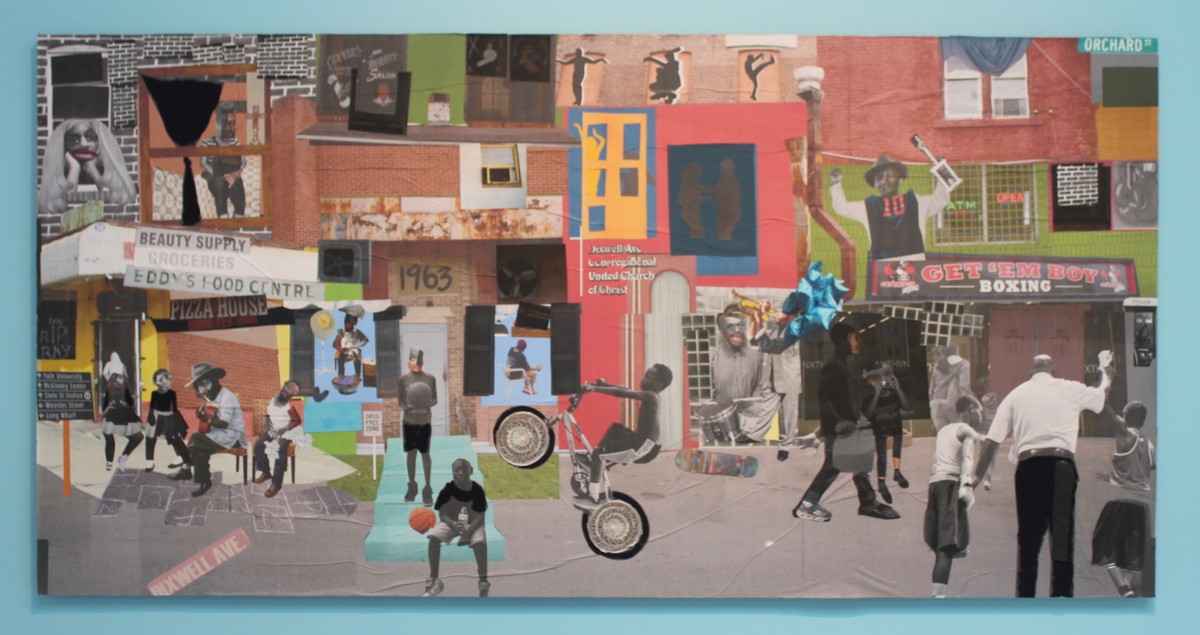
SHAN Wallace
New Haven Block Party.
SHAN Wallace’s New Haven Block Party captures the essence of its title and then some. It conveys something of the way the past and present can collide on some of Dixwell’s streets, how the shadows of what used to be there can feel as present as what’s there now. But it honors what’s there now, too: the people, the places, the energy that make up the neighborhood as we experience it today. True to the season, it feels like a hot summer day, when windows are open and radios are loud, and people are ready to talk to each other on stoops and street corners in ways the colder months won’t allow.
Wallace’s piece is part of “Common Practice: Public Access,” an exhibition running at NXTHVN on Henry Street through Sept. 3. The show “supports a point of entry for the Dixwell community and Greater New Haven residents to engage with artists and ideas that connect with their true-to-life experiences,” an accompanying note states. “The works on these walls convey everyday moments,” with the artists using “access to public space to explore the impact of basketball as a cultural medium, and its capacity for community building.… More than just a game, it has reshaped perceptions of what a sport can mean beyond surface level competition, and prompted new avenues for civic engagement and social impact.”
In focusing on the cultural effects of basketball, the show — which features work from Anwulika Anigbo, Jeanne Moutoussamy-Ashe, Kevin Couliau, Sue Kwon, Hope Mora, Daniel Ramos, Robin Rhode, Tschabalala Self, Paul Anthony Smith, Ashley Tillery, SHAN Wallace and Kim Weston — gets a deeper, more elusive point: it blurs the lines between art and life, and shows how the practice of sports, art, and life can be one and the same.

Hope Mora
Hannah's Quince.
Several of the photographs in the exhibition show how people all over the world gather on basketball courts even when they don’t do it to play basketball. Musicians hold concerts on them. Teenagers hang out on them. And as Hope Mora’s photograph shows, young women prepare for major life events. Several other photographs show another side of that coin; to moving effect, they illustrate how players form a camaraderie on the court that they then carry off the court and into the neighborhoods where they live.

Kevin Couliau
Blacktop Memento
Other photographs in the exhibition show the ways that basketball has traveled the world, which means that someone will skill at the sport can go just about anywhere and find a game to play in, with a smile and a nod. Kevin Couliau’s images, from courts separated by thousands of miles, from Guadeloupe to Harlem to France to Senegal, show how the similarities shrink those distances. The location may change, but the rules are the same, and they can bring people together without them having to utter a word.

The final piece in the show, by Tschabalala Self — this reporter recommends visiting it after spending time with the pieces in the Henry Street gallery — consists of eyes drawn on the surface of the basketball courts at Goffe Street Park. Self has the courts bear witness to what goes on there, and asks us to bear witness too.
When this reporter visited, sure enough, almost as the photographs in the exhibition promised, several pickup games filled the park’s courts. The air sparked with the players’ movements, the words that passed between them. Others waited their turn, cheered and applauded for the plays they liked best. The life on the courts in the park enacted and embodied what the photographs in the gallery conveyed. The people in the park erased the lines between art, sports, and life. They took risks, and pushed themselves and those around them to play their best. They built community with every shot.